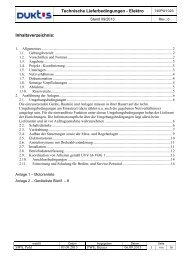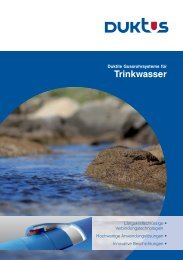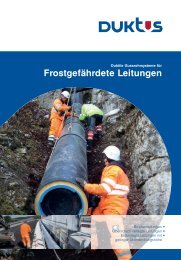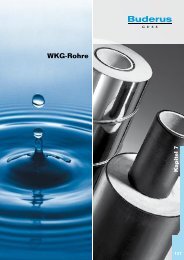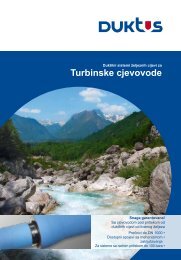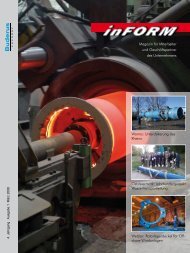Buderus Manual on Trenchless Installation of Ductile Cast ... - Duktus
Buderus Manual on Trenchless Installation of Ductile Cast ... - Duktus
Buderus Manual on Trenchless Installation of Ductile Cast ... - Duktus
Create successful ePaper yourself
Turn your PDF publications into a flip-book with our unique Google optimized e-Paper software.
The pipe relining technique<br />
7. Renovati<strong>on</strong> <strong>of</strong> supply and drainage pipelines with ductile<br />
cast ir<strong>on</strong> pipes by the relining technique<br />
7.1 General<br />
When pipelines are renovated by the relining technique, a new pipeline is pulled or<br />
pushed into an existing pipeline. This always results in a reducti<strong>on</strong> in the hydraulic crosssecti<strong>on</strong><br />
<strong>of</strong> the pipeline. When relining is carried out with ductile cast ir<strong>on</strong> pipes, the<br />
reducti<strong>on</strong> in the cross-secti<strong>on</strong> <strong>of</strong> the pipeline depends <strong>on</strong> the outside diameter <strong>of</strong> the<br />
sockets in the new pipeline. The pipeline suffers a loss <strong>of</strong> hydraulic performance. To<br />
some degree this is compensated for by the smooth interior surface <strong>of</strong> the new pipeline<br />
(the low roughness <strong>of</strong> its walls). Old pipelines are <strong>of</strong>ten encrusted <strong>on</strong> the inside and<br />
the roughness <strong>of</strong> their walls is therefore high. The relining technique can be used for<br />
drinking water pipelines, industrial water pipelines, pressure waste water pipelines and<br />
gravity waste water pipelines.<br />
In Germany, the c<strong>on</strong>sumpti<strong>on</strong> <strong>of</strong> drinking water by the populati<strong>on</strong> and by industry is<br />
going down. A reducti<strong>on</strong> in the hydraulic cross-secti<strong>on</strong> <strong>of</strong> a pipeline is therefore <strong>of</strong>ten<br />
an advantage to the operator, because the rate <strong>of</strong> flow <strong>of</strong> the water is accelerated again<br />
and the dwell time <strong>of</strong> the water in the pipeline is shorter, by which means it is <strong>of</strong>ten<br />
possible for health problems to be avoided.<br />
With waste water pipelines too, the rate <strong>of</strong> flow goes up as a result <strong>of</strong> the relining, and<br />
in many cases this is a way <strong>of</strong> stopping the solids carried in the waste water from settling.<br />
Because <strong>of</strong> deposits <strong>of</strong> solids, waste water pipelines <strong>of</strong>ten have to be cleaned at<br />
relatively short intervals by high-pressure flushing or by using go-devils.<br />
Wherever there are pipelines where the intervals between changes <strong>of</strong> directi<strong>on</strong> or<br />
lateral c<strong>on</strong>necti<strong>on</strong>s are not too short, renovati<strong>on</strong> by the relining technique is always<br />
more ec<strong>on</strong>omical than renovati<strong>on</strong> by relaying in open trenches. This is true above all<br />
<strong>of</strong> runs <strong>of</strong> pipes below paved or metalled surfaces (e.g. surfaces carrying traffic) or in<br />
built-up areas.<br />
7



